
Hong Kong has a highly developed transport network, encompassing both public and private transport. Based on Hong Kong Government's Travel Characteristics Survey, over 90% of daily journeys are on public transport, the highest rate in the world. However, in 2014 the Transport Advisory Committee, which advises the Government on transportation issues, issued a report on the much-worsened congestion problem in Hong Kong and pointed at the excessive growth of private cars during the past 10–15 years.

A people mover or automated people mover (APM) is a type of small scale automated guideway transit system. The term is generally used only to describe systems serving relatively small areas such as airports, downtown districts or theme parks.

Hong Kong International Airport is an international airport located on the island of Chek Lap Kok in western Hong Kong. The airport is also referred to as Chek Lap Kok International Airport or Chek Lap Kok Airport, to distinguish it from its predecessor, the former Kai Tak Airport.

Beijing Capital International Airport is one of two international airports serving Beijing, the capital city of China, the other one being Beijing Daxing International Airport (PKX). It is located 32 km (20 mi) northeast of Beijing's city center, in an exclave of Chaoyang District and the surroundings of that exclave in suburban Shunyi District. The airport is owned and operated by the Beijing Capital International Airport Company Limited, a state-controlled company. The airport's IATA Airport code, PEK, is based on the city's former romanized name, Peking.

Shanghai Pudong International Airport is one of two international airports serving Shanghai, the municipality in East China, and a major aviation hub of East Asia. Pudong Airport serves both international flights and a smaller number of domestic flights, while the city's other major airport, Shanghai–Hongqiao, mainly serves domestic and regional flights in East Asia. Located about 30 kilometres (19 mi) east of the city center, Pudong Airport occupies a 40-square-kilometre (10,000-acre) site adjacent to the coastline in eastern Pudong. The airport is operated by Shanghai Airport Authority.

An airport terminal is a building at an airport where passengers transfer between ground transportation and the facilities that allow them to board and disembark from an aircraft.
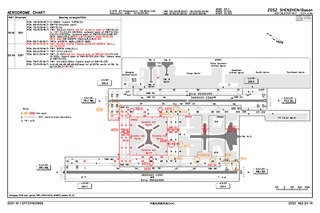
Shenzhen Bao'an International Airport is an international airport serving the city of Shenzhen in South Central China’s Guangdong province. It is on the east bank of the Pearl River near Huangtian and Fuyong villages in Bao'an District, 32 km (20 mi) northwest of the city centre. It is a hub for Shenzhen Airlines and Shenzhen Donghai Airlines and for cargo airline SF Airlines, China Southern Airlines and Hainan Airlines. The airport also serves as an Asian-Pacific cargo hub for UPS Airlines. The airport underwent major expansions in the 2010s, with a second runway opening in 2011, and a new terminal in 2013.

Hong Kong SkyCity is a large business and entertainment complex adjacent to Hong Kong International Airport, and is built on land owned by the Airport Authority Hong Kong. It currently includes the AsiaWorld–Expo, Terminal 2 (SkyPlaza) and SkyPier.

The Changi Airport Skytrain is an automated people mover (APM) that connects Terminals 1, 2 and 3 at Singapore Changi Airport. Opened in 1990, it was the first driverless and automated system of its kind in South East Asia. The Changi Airport Skytrain operates from 05:00 to 02:30 daily. Traveling on the Skytrain is free and an inter-terminal journey takes approximately four minutes.

The Plane Train is a 24/7 automated people mover (APM) located at Hartsfield–Jackson Atlanta International Airport. Made by Westinghouse Electric Corporation and maintained by Bombardier, it transports passengers between the terminals and the airside concourses. The system is the world's most heavily traveled airport APM, with 64 million riders as of 2002.

The Harry Reid International Airport People Movers are three separate automatic people mover systems operating at Harry Reid International Airport near Las Vegas, Nevada. The people mover system consists of three separate lines: the Green Line connecting the Main Terminal to the C Gate Concourse, the Blue Line connecting the Main Terminal to the D Gate Concourse, and the Red Line connecting the D Gates Concourse to Terminal 3. Each line currently uses CITYFLO650 radio-based moving block signaling technology, which was introduced to the tram system when the Green and Blue Lines when the vehicles were replaced, the Red Line has always used moving block signaling technology as it opened in 2012 and it is the newest of the three lines.

Hongqiao Railway Station is a Shanghai Metro station located within the Shanghai Hongqiao railway station complex in the city's Minhang District. As part of a major transportation hub, it serves as an interchange between Lines 2, 10, and 17. It additionally serves as the western terminus the mainline service of Line 10, as well as the eastern terminus of Line 17. The station first opened as a Line 2 station on 1 July 2010, with Line 10 operations commencing on 30 November 2010. More than seven years later, Line 17 service was introduced with the opening of that line on 30 December 2017. With three island platforms totaling six platforms, the station is one of the largest in the system and features a cross-platform interchange between Lines 2 and 17.
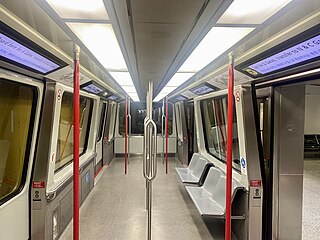
The SEA Underground, formerly called the Satellite Transit System (STS), is an automated people mover (APM) system operating in the Seattle–Tacoma International Airport in SeaTac, Washington, United States. Originally opening in 1973, the SEA Underground is one of the oldest airport people mover systems in the world. The APM was designed to quickly transport passengers to and from the North and South Satellites, and around the airport's Main Terminal.

Skypier Terminal is a cross-border facility that includes a ferry pier and a coach bay integrated within Hong Kong International Airport, Chek Lap Kok, New Territories, Hong Kong. It is operated by Hong Kong International Airport Ferry Terminal Services Limited, a joint-venture company between Chu Kong Passenger Transport Co., Ltd and Shun Tak-China Travel Ship Management Limited. At this building, passengers aboard can transit from Hong Kong International Airport to piers in the Pearl River Delta of Guangdong Province or vice versa, without immigration and customs clearance through Hong Kong. Passengers can also transit to Macao through coaches or vice versa, without immigration and customs clearance through Hong Kong.
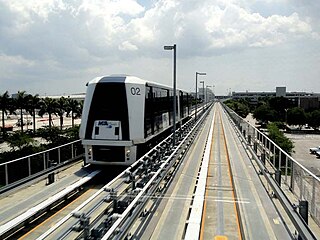
The MIA Mover is an automated people mover (APM) system which opened at the Miami International Airport (MIA) in metropolitan Miami, Florida, United States on September 9, 2011. The MIA Mover is designed to quickly transport landside passengers between Miami International Airport's Main Terminal and the Miami Intermodal Center (MIC). The MIA Mover is one of three separate automated people movers operating at the airport. The others are the Skytrain, which operates within Concourse D, and the MIA e Train people mover connecting Concourse E's satellite building.
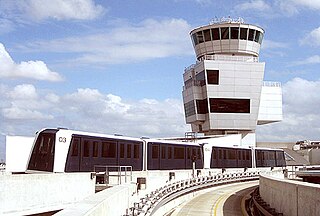
The Skytrain is a people mover at Miami International Airport (MIA) in Miami-Dade County, Florida, United States. One of three people movers at MIA, it operates within Concourse D and connects four stations over a distance of 0.70 miles (1.12 km). It uses Crystal Mover trains, which are fully-automated and travel along the roof of the terminal. The system has transported up to 40,000 passengers daily.

Innovia APM is a rubber-tired automated people mover system (APM) currently manufactured and marketed by Alstom as part of its Innovia series of fully automated transportation systems. The technology was introduced in 1963 by Westinghouse and has been improved over three generations: the Innovia APM 100, Innovia APM 200, and the latest model, the Innovia APM 300. The license to use the technology has also passed hands several times, from Westinghouse to AEG in 1988, to Adtranz in 1996, to Bombardier Transportation in 2001, and most recently to Alstom in 2021.
The Dubai International Airport Automated People Mover is a driverless people mover located within Dubai International Airport. It operates in two "segments" within Terminal 3 and Concourse A & B, often referred to as the Terminal 3 APM, and between Terminals 1 and Concourse D will referred to as the Terminal 1 APM.
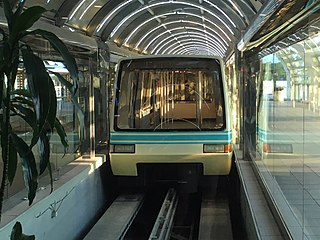
The Orlando International Airport People Movers are a set of automated people mover (APM) systems operating within Orlando International Airport. The four original people mover systems connect the airport's main terminal to four satellite airside concourses. A fifth AGT people mover system was installed in 2017 to connect the main terminal with the airport's new Intermodal Terminal.

Shanghai Pudong Airport APM is an automated people mover in the Pudong International Airport. In the initial phase, there are two lines, each connecting a terminal building and a satellite hall. The two lines are planned to be connected after the completion of Terminal 3 in the future. The system uses Class A stocks, currently in a 4-car configuration, with conditions reserved for a 5-car configuration across the fleet.























